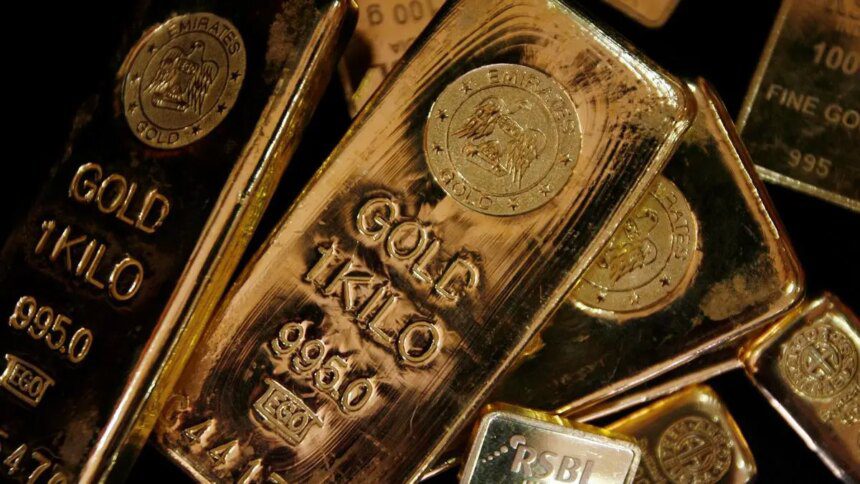Highlights
- Gold is viewed as a hedge by investors
- Gains traction amid inflation and economic slowdown concerns
- Relationship observed between stocks and gold
Investors are re-evaluating well-established perspectives on gold, which has surged to new record highs amidst an AI-led stock rally and rising bitcoin valuations. Gold reached $4,000 an ounce for the first time this week and has seen a 53 percent increase in 2025, marking its strongest performance since 1979. This outpaces bitcoin’s 30 percent rise and the S&P 500’s 15 percent increase, which includes major technology firms.
The yellow metal typically flourishes when investors are anxious about inflation, economic downturns, or potential market volatility. In contrast, it tends to lag behind more appealing alternatives when investor risk appetite improves.
This pattern echoes historical instances such as in 1980 when gold climbed as U.S. inflation eclipsed 13 percent and the economy and stocks faltered, and in early 2008, when the global financial crisis saw Wall Street shares lose 32 percent within six months.
Gold and Stocks’ Unusual Partnership
Currently, gold is soaring alongside stocks and bitcoin, fueled by expectations of U.S. interest rate cuts and concerns regarding the dollar’s status as the world’s primary reserve currency. Pictet senior multi-asset strategist Arun Sai stated, “When there is a paradigm shift in our economic system, historically, people gravitate towards gold. Consider it the ultimate hedging asset.”
In addition, political uncertainties, including budgetary issues in France and concerns about central bank independence, have unsettled investors. Ongoing conflicts, such as the war in Ukraine and potential peace developments in Gaza, further compound this uncertainty.
The recent AI surge has driven Wall Street, leading to fears of a speculative bubble. Former President Donald Trump’s robust spending plans and critiques of the Federal Reserve have weakened Treasuries and the dollar, the latter of which has depreciated by 10 percent against other major currencies this year.
Jamie Dimon, CEO of JPMorgan Chase, has highlighted an increased likelihood of a significant stock market correction in the U.S. over the next six months to two years. Heightened tariffs have also exacerbated inflation fears, another factor supporting gold.
Michael Metcalfe, head of macro strategy at State Street, remarked, “It seems we are at an inflection point for inflation.” Anxiety about the independence of the Federal Reserve and inflation may be interrelated, particularly as market perceptions grow that the influential central bank may remain passive as inflation driven by tariffs escalates.
As of September, inflation among the G7 nations averaged 2.4 percent, compared with 1.7 percent the previous year, with many central banks either cutting rates or maintaining current levels.
Since August, gold has appreciated by approximately 20 percent as tensions rise around Fed officials, amplifying Trump’s attempts to influence the central bank.
Stock and Gold Spillover
While the U.S. labor market is showing signs of cooling, other economic indicators remain robust, with rising inflation expectations. Traders anticipate U.S. interest rate cuts extending into 2026, benefiting both equities and gold.
Rhona O’Connell, head of market analysis for EMEA and Asia at StoneX, noted that the concept of the “efficient frontier” partly accounts for the simultaneous rise of gold and stocks. The efficient frontier refers to the ideal balance between maximized returns and acceptable risk for portfolio managers. Gold traditionally moves inversely to stocks, making it an effective risk mitigator.
When gold prices rise, portfolio managers can increase their allocations to gold to reduce stock market risk while achieving higher returns. “When equities experience strong growth, some of that value tends to spill over into gold holdings,” O’Connell added.
Gerry Fowler, head of equity strategy at UBS, also pointed out increased retail demand impacting the gold price. “Every time someone increases their investment in gold ETFs, the ETF must purchase physical gold,” he explained, highlighting broader trends of “bubbly behavior” and “retail enthusiasm.”
AI Hedge
Concerns over a potential collapse in AI-driven stocks, echoed by commentary from the Bank of England and the IMF, suggest that gold is also being seen as a hedge against this risk. Trevor Greetham, head of multi-asset at Royal London Asset Management, noted, “Investors are equally optimistic about AI and gold. A severe recession alongside an AI downturn might push gold prices up further.”
Gold’s ascent is largely attributed to diminishing confidence in the dollar. Central banks have increasingly turned to gold, now holding approximately a quarter of their reserves in bullion to diversify away from the dollar.
Nutshell Asset Management CIO Mark Ellis anticipates this trend to persist, as U.S. tariffs compel exporters to seek alternate markets, reducing dependency on the dollar. Ellis summed up his perspective on the current gold surge by stating, “It’s Donald Trump.”
Published on October 10, 2025










